Sustainability
Sustainability
Environmental Conservation
Conservation of the Global Environment
The OPEN HOUSE Group promotes sustainability aiming to contribute to the realization of a sustainable society through our business activities while achieving sustainable corporate growth. Recognizing that our business activities affect the environment, we will promote initiatives to reduce environmental impact and conserve the environment, both within the Group and throughout our entire value chain.
Our environmental conservation activities are conducted based on our “OPEN HOUSE Group’s Environmental Policy.”
For more information:
OPEN HOUSE Group’s Environmental PolicyApproach to Climate Change
The OPEN HOUSE Group recognizes that climate change is a major environmental issue that has a major impact on its business activities, and that it is a risk in providing the houses that customers want. that the Group is aiming for.
In December 2020, the Japanese government announced its goal of reducing emissions of greenhouse gases to virtually zero by 2050, and Initiatives toward decarbonization in Japan are accelerating.
The Group-wide efforts, centered on Sustainability Committee, will also be earnest in dealing with issues that will lead to the realization of a decarbonized society.
Recognizing these challenges, the Group is working to reduce greenhouse gas emissions through the efficient use of energy and the promotion of the use of renewable energy in our business bases and the housing we provide to our customers, and to reduce the impact of our business activities on climate change.
In the decarbonization project, we are making concrete efforts to realize a decarbonization society through multi-faceted energy creation and renewable energy projects.
We will continue to work with our stakeholders to tackle the issues of climate change and energy consumption with the aim of realizing a decarbonized society.
Agreement with the Recommendations of TCFD
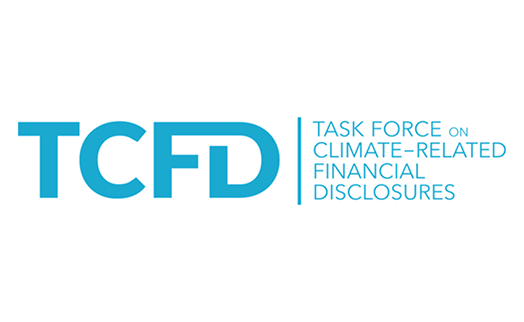
In January 2021, the Group declared its agreement with the recommendations of the Task Force on Climate-related Financial Disclosures (TCFD) to companies for disclosing information regarding risks and opportunities related to climate change. As a member of the TCFD Consortium, a group of Japanese companies that are in agreement with the TCFD, we are working to provide disclosures in line with the TCFD recommendations.
For more information:
TCFD Website (English)Information Disclosure on Climate Change based on the TCFD Recommendations
1. Governance
The Company recognizes climate change as one of the issues that have a material effect on its management. It positions the Sustainability Committee, chaired by the Managing Director who serves as Division Director of the Corporate Planning Division and composed of division heads, as the body responsible for climate change-related issues. The Sustainability Committee regularly evaluates the Company’s response to various issues related to climate change. Furthermore, the Board of Directors monitors the Sustainability Committee, and reports and deliberates on important policies and matters.
<Operating structure>
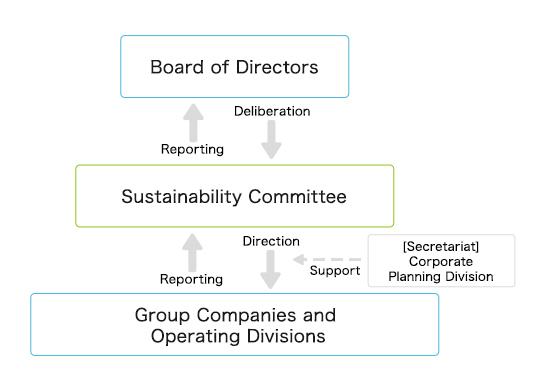
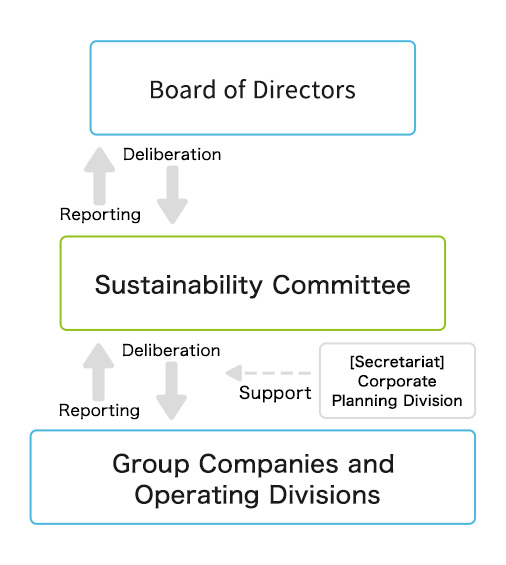
2. Strategy
The OPEN HOUSE Group has identified risks and opportunities presented by climate change envisioned for 2030 for its mainstay single-family homes related business. It also analyzed the financial effects based on two scenarios envisioned by the Intergovernmental Panel on Climate Change (“IPCC”) and considered future response policies as follows.
(1) Scenario analysis assumptions (definitions)
| (i) 1.5°C scenario | (ii) 4°C scenario | ||
|---|---|---|---|
| Transition risk | Risks and opportunities associated with changes in policies, rules, technologies, the market, customer preferences, etc. during the transition period to a low-carbon society. | Strict global climate change policies are thoroughly implemented, succeeding in limiting global warming. As a result, the average temperature in 2050 only rises by 1.5°C compared to before the Industrial Revolution in the 18th century. | Despite various calls for attention to global warming, the world’s nations are unable to cooperate, and strict policies are not introduced. As a result, global warming progresses further, the average temperature rises by 4°C, and natural disasters become more severe and frequent. |
| Physical risk | The acute risk such as natural disasters becoming more severe and frequent due to climate change, and the chronic risk such as rising average temperatures and abnormal weather. |
(2) Results of scenario analysis
(i) 1.5°C scenario
In the 1.5°C scenario, the transition risk of introducing a carbon tax and mandating solar panels is seen as the main factor pressuring earnings. However, winning new customers by providing homes with a low environmental impact is an earnings opportunity. In terms of the physical risk, the risk from natural disasters, etc. is negligible. Overall, we have concluded that the financial effects in this scenario are limited.
(ii) 4°C scenario
In the 4°C scenario, we concluded that there is no significant transition risk. In terms of physical risk, the single-family homes related business operated by the OPEN HOUSE Group is a short-flow business. Because of this, by increasing our sensitivity to changes in the external environment such as intensifying natural disasters, we can reduce risks, and have concluded that there are no significant financial effects in this scenario.
<List of risks, opportunities, and financial effects>
| Risks and opportunities/Items | Effects | Financial effects | ||
|---|---|---|---|---|
| 1.5℃ | 4℃ | |||
| Transition risk・Opportunity | [Risk] Carbon tax introduction | Rising procurement costs of materials, etc. from the introduction of the carbon tax (Rising construction contracting costs) | ↓ | - |
| Rising fuel costs for company vehicles from the introduction of the carbon tax | ↓ | - | ||
| Rising electricity usage costs from the introduction of the carbon tax | ↓ | - | ||
| [Risk] Mandated installation of solar panels | Rising costs (0% pass-through rate to sale price) from the mandated installation of solar panels (60%) | ↓ | - | |
| [Opportunity] Rising demand for homes with a low environmental impact | Increased earnings with the provision of homes with a low environmental impact (ZEH Oriented) | ↑ | - | |
| Physical risk | [Risk] Effects of intensifying typhoons and floods | Increased costs due to periods of suspended operations from intensifying typhoons and floods | - | - |
| Decreased earnings from price decreases in homes under construction from intensifying typhoons and floods | ↓ | ↓ | ||
| [Risk] Increased negative health effects from severe heat (heatstroke, etc.) | Increased costs due to reduced productivity of construction workers from severe heat | ↓ | ↓ | |
| Decreased earnings from reduced sales efficiency of sales staff from severe heat | ↓ | ↓ | ||
- ↑/↓
- : absolute value of ¥1 billion or more and less than ¥5 billion
- Not applicable
- : absolute value of ¥100 million or more and less than ¥1 billion
- ↑/ ↓
- : absolute value of ¥10 million or more and less than ¥100 million
- -
- : no financial effect, or an absolute value of less than ¥10 million
(3) Future response
As a result of the above analysis, we confirmed that reducing the cost of cutting GHG emissions and mandated solar panel installation is effective in reducing risk and that providing homes with a low environmental impact presents an earnings opportunity.
To reduce GHG emissions, Scope 1, 2 (*) will be gradually replaced with vehicles that have a lower environmental impact, and energy conservation will be continued.
In October 2022, we also expect to achieve our target through energy creation through investment in the solar power business, which we launched as one of our Open House Group Decarbonization Projects.
We recognize that Scope 3 (*) accounts for a high percentage of our total emissions, and that response is critical.
For this reason, in October 2022, under the Open House Group Carbon-Free Project, through our subsidiary Ochi Link Co., Ltd. ("Ochi Link"), we switched the electric power services provided to customers who purchased detached houses in the Group to virtually renewable energy.
Through the dissemination of this service, we aim to achieve our Scope 3 emissions reduction targets.
On the other hand, regarding the installation of solar panels, even if solar panels are installed in the single-family homes provided at low cost in good locations by the OPEN HOUSE Group’s single-family homes related business, because the size of lots is limited, the amount of power produced by current solar panels will not cover the energy needs of an average home.
In addition to expectations for future technological advances, we will cooperate with the supply chain and strive to disseminate them in light of their balance with our business.
Furthermore, regarding the provision of homes with a low environmental impact, for locations that meet set conditions (locations in use districts subject to the north oblique line restriction [Category 1 and 2 low-rise exclusive residential districts and Category 1 and 2 medium-to-high-rise exclusive residential districts] with a total lot area of less than 85 m2), a “ZEH Oriented” category has been established for homes with a low environmental impact that do not require solar panel installation (cutting-edge ZEH-oriented homes with a high level of exterior thermal insulation and high-efficiency, energy-saving equipment). Certain regions in which the OPEN HOUSE Group is operating its single-family homes related business meet the above conditions. However, there are issues that must still be solved for commercialization, including the space and costs currently required to install high-efficiency, energy-saving equipment and the omission of certain heating equipment.
Therefore, while following the trends of government regulations, heightened customer awareness of carbon reduction, technological innovation in solar power generation equipment, etc., we will continue to consider said issues to choose the best methods for all our stakeholders, in view of economic rationality.
3. Risk management (system)
The Sustainability Committee of the Company formulates a basic policy on environmental issues and manages risks created by climate change. The Sustainability Committee identifies the issues facing the OPEN HOUSE Group by following trends in Japan and the world in response to climate change, including exchanging information with external experts. It also discusses the necessary policies with Group companies and operating divisions, and regularly monitors the progress of those policies. The Sustainability Committee also manages the progress of the established GHG emission reduction targets, and continuously considers raising the targets further. The Sustainability Committee regularly reports to the Board of Directors on the climate change issues and the progress of initiatives to address the issues. Through these efforts, the Company has developed a system to respond appropriately to the risks and opportunities presented by climate change, which is expected to further diversify, expand and intensify in the future.
4. Metrics and targets
In November 2021, we set our first medium-to long-term GHG emissions reduction target to reduce the risks associated with climate change, based on scenario-based analysis. In October 2022, we added Scope 3 to the target.
In the future, we will promote Open House Group Decarbonization Project in order to achieve our targets.
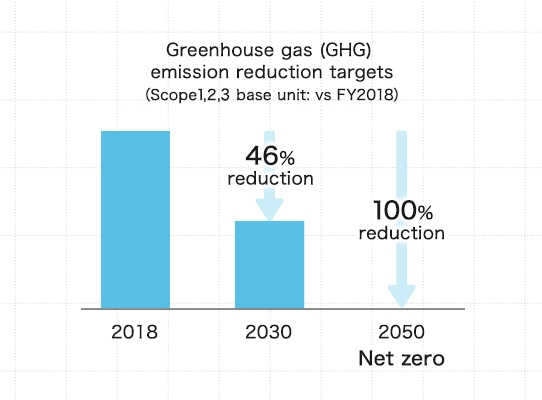
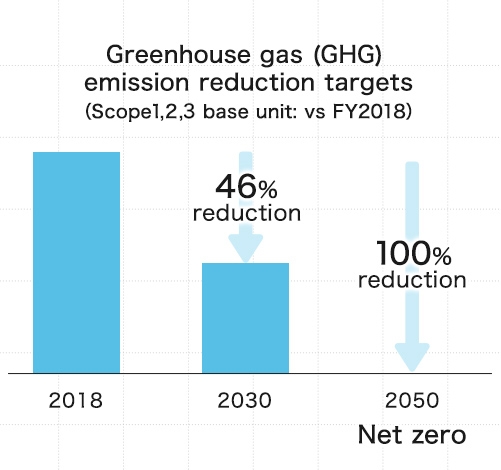
- Scope 1
- : emissions from the business activities of covered companies (direct emissions)
- Scope 2
- : emissions produced from the use of energy provided by other companies (indirect emissions)
- Scope 3
- : emissions from other business activities (indirect emissions mainly from materials procurement and the use of homes after sale)
About Japan Wood-Housing Association

Japan Wood-Housing Association was established in April 2021 by three housing manufacturers, MELDIA CO., LTD., Open House Group Co., Ltd., and KI-STAR REAL ESTATE CO., LTD, to resolve Japanese forestry and environmental issues through the use of domestic timber. The President and Representative Director of the Group serves as the director, and the Group employees participate as the secretariat for the operation of the system.
Japan Wood-Housing Association aims to realize the value of wooden houses and resolve environmental issues by establishing a sustainable development cycle of domestic Lumber through "logging," "using," "planting," and "nurturing," and supporting the promotion of the use of domestic Lumber with the aim of realizing a sustainable society with wooden houses. Through Initiatives at the Institute, we will strive to contribute to the environmental issues that are unique to Japan.
Objectives
- Promote high-quality wood houses that people can live in worry-free and achieve the sound development of the industry for wood houses built for sale
- By promoting the use of domestic lumber for wood houses built for sale, restore and maintain various functions of domestic forests (reduction of greenhouse gases, cultivation of water sources and conservation of biodiversity)
Activities
- Support the promotion of domestic lumber usage
- Technological development and research on wood buildings
- Research and development to improve the capabilities and quality of wood buildings, and promotion of public awareness
- Human resource development related to wood buildings
- Development and research on the supply system of temporary wood housing in the event of a disaster
- Presentation of proposals and opinions to government agencies and related organizations
- Other activities necessary to achieve the objectives of the association
- Activities shall be conducted throughout Japan and overseas
The Challenges of the Society's Domestic Lumber
The wooden housing sector uses a low percentage of domestically produced Lumber and relies mostly on imported Lumber from abroad. As a result, the number of domestic forestry workers has declined, the unit price of domestic Lumber has risen, and the environmental impact of importing foreign timber has resulted in social issues.
The complexity of Japan-specific distribution routes is also a cost-factor, which is a barrier to domestic Lumber distribution.
In addition, destabilization of prices and supplies of foreign timber due to the recent social situation of geopolitical risks has affected the stable supply of domestically produced Lumber.
The Institute is committed to resolving social issues by conducting a variety of activities aimed at resolving the social issues faced by domestic Lumber.
The Japan Wood-Housing Association's Initiatives
Building a new distribution model for domestic timber
In Japan, the current situation is that foreign timber is primarily used in the construction of houses. As the distribution volume of domestic timber decreases, it inevitably leads to a further decrease in production volume, which in turn inevitably increases the unit price.
Additionally, another major factor causing the high cost of domestic timber is the complexity of the distribution route from logging to delivery to the construction company.
By securing a certain level of distribution, Japan Wood-Housing Association aims to generate stable demand for its mountains and plants by creating a new distribution of domestically produced Lumber that deals directly with forest owners and sawmills and enters into business alliances, thereby stabilizing the supply and cost of domestically produced Lumber.
By recruiting members widely and continuing and expanding our own distribution system, we aim to contribute to the vitalization of the forest cycle and to establish a distribution environment in which housing companies in various parts of Japan can use domestically produced materials in a stable manner.
Tree planting and afforestation activities
The total amount of domestic Lumber distributed by this association is converted into roundwood and planted for the number of trees in the following fiscal year.
Tree planting results
| Tree planting area | 2022 results |
|---|---|
| Aomori Prefecture | 15,000 |
| Akita Prefecture | 13,500 |
Supporting the Development of Forestry Human Resources
Japan's forestry industry faces the challenge of not being able to secure production of domestically produced logs due to a shortage of logging craftsmen.
We continuously promote exchanges with forestry associations and federations throughout the country, mainly in the Tohoku and Northern Kanto regions, and provide support for forestry Talent Development and encourage related organizations.
Initiatives to Reduce Greenhouse Gas Emissions and Promote Energy-Saving in Products
The Group considers that climate change due to greenhouse gas emissions will have a significant impact on the long-term sustainability of society. In addition, we recognize that abnormal weather and natural disasters caused by climate change could pose serious risks to our business activities and growth. We are therefore promoting initiatives on various fronts, such as reducing greenhouse gas emissions associated with business activities and promoting energy-saving in houses.
Our initiatives to reduce greenhouse gas emissions in each business year are as follows.
Emissions by Scope (CO2)
In fiscal 2021, the sum of Scope 1, 2 increased slightly, but the basic units per business site area decreased slightly due to the expansion of the business area.
With regard to Scope 3, in our business, the percentage of greenhouse gases from Category 11 (electricity and city gas assumed when the houses sold are used for 30 years) accounts for 73% of the total emissions. Therefore, we believe it is crucial to build houses that reduce energy consumption and reduce emissions of greenhouse gases in the provision and operation of houses.
In the future, we will continue to work on the use of eco-friendly vehicles for sales and on improving the insulation performance of construction materials.
Actual energy consumption per unit of sales by type decreased slightly.
We will continue our efforts to reduce the environmental impact of our business as a whole.
[Note on calculation data]
Data related to climate change is calculated based on the following.
Subject of the calculation: OPEN HOUSE’s single-family homes related business
Subject period: Fiscal year (April to March each year)
Unit: tCO2
| Scope and Category | Target activities for calculation | FY2018 | FY2019 | FY2020 | FY2021 | FY2022 | Ratio |
|---|---|---|---|---|---|---|---|
| Scope 1: Direct emissions of greenhouse gases from business activities | Fuel usage at business sites and of company vehicles | 618 | 776 | 983 | 981 | 1,118 | 0.11% |
| Scope 2: Indirect emissions of greenhouse gases associated with the use of energy supplied by other companies | Electricity usage at business sites and construction sites | 1,445 | 1,770 | 1,762 | 1,897 | 1,748 | 0.17% |
| Scope 1 and 2 total | 2,063 | 2,546 | 2,745 | 2,878 | 2,866 | 0.28% | |
| Scope 3: Indirect emissions other than Scope 1 and 2 | 552,739 | 667,188 | 771,620 | 809,416 | 1,011,167 | 99.72% | |
| Category 1: Purchased goods and services | Paper, water supply and construction contracted to other companies | 132,010 | 154,097 | 178,095 | 193,974 | 260,820 | 25.72% |
| Category 2: Capital goods | Acquisition of property, plant and equipment | 1,195 | 1,004 | 1,323 | 1,361 | 835 | 0.08% |
| Category 3: Fuel- and energy-related activities not included in Scope 1 or Scope 2 | Fuel and electricity usage | 346 | 434 | 492 | 469 | 539 | 0.05% |
| Category 4: Upstream transportation and distribution | Included in Category 1 | - | - | - | - | - | - |
| Category 5: Waste generated in operations | Industrial waste generated at construction sites | 3,068 | 3,360 | 4,885 | 5,445 | 6,838 | 0.67% |
| Category 6: Business travel | Employee business trips (air travel, railway travel, taxi and accommodations) | 128 | 134 | 75 | 110 | 1,309 | 0.13% |
| Category 7: Employee commuting | Employee commuting (train) | 226 | 246 | 238 | 247 | 325 | 0.03% |
| Category 8: Upstream leased assets | Included in Scope 1 and 2 | - | - | - | - | - | - |
| Category 9: Downstream transportation and distribution | Not applicable | - | - | - | - | - | - |
| Category 10: Processing of sold products | Not applicable | - | - | - | - | - | - |
| Category 11: Use of sold products | Projected use of electricity and city gas in sold houses over 30 years | 406,892 | 496,864 | 573,378 | 594,198 | 723,090 | 71.31% |
| Category 12: End-of-life treatment of sold products | Projected industrial waste generated upon demolition of sold houses | 8,874 | 11,048 | 13,135 | 13,611 | 17,411 | 1.72% |
| Category 13: Downstream leased assets | Not applicable | - | - | - | - | - | - |
| Category 14: Franchises | Not applicable | - | - | - | - | - | - |
| Category 15: Investments | Not applicable | - | - | - | - | - | - |
| Scope 1, 2 and 3 total | 554,802 | 669,734 | 774,366 | 812,294 | 1,014,033 | 100% | |
Scope 1 and 2 Emission Amounts and Intensities per Unit of Business Site Area
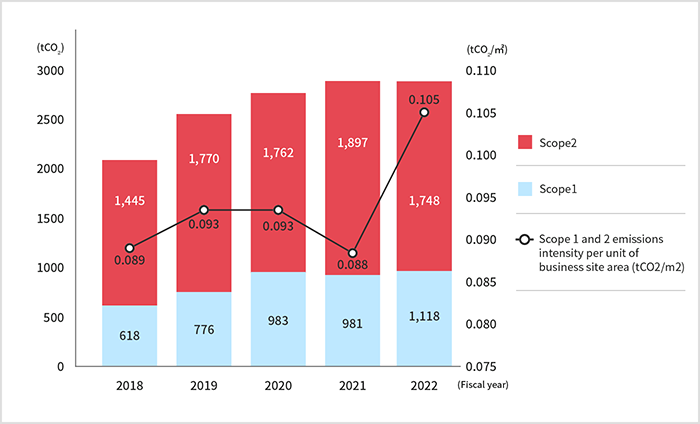
Scope 3 Emission Amounts and Intensities per Unit of Net Sales
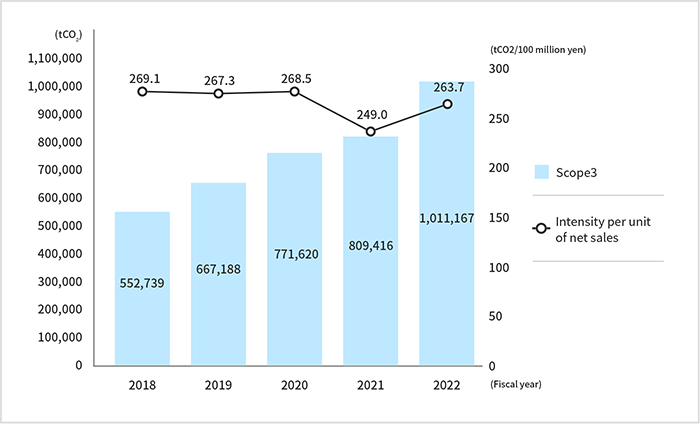
Scope 3 Total Emissions and Breakdown by Category (Fiscal 2022)
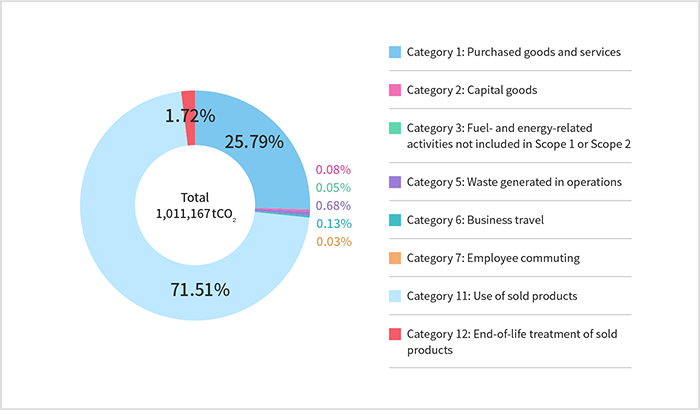
Energy Consumption by Type
Unit: GJ
| Energy type | FY2018 | FY2019 | FY2020 | FY2021 | FY2022 |
|---|---|---|---|---|---|
| Gasoline | 9,139 | 11,430 | 14,558 | 14,544 | 16,617 |
| City gas | 105 | 194 | 148 | 112 | 80 |
| Electricity | 28,209 | 35,399 | 36,591 | 39,388 | 38,696 |
| Total | 37,454 | 47,023 | 51,297 | 54,044 | 55,393 |
Energy Consumption by Type
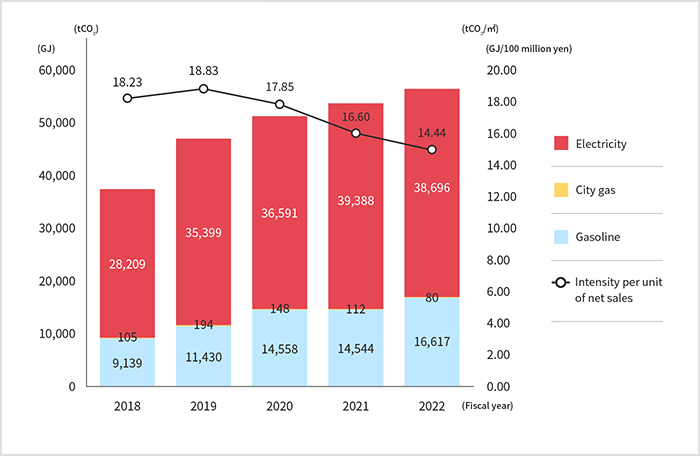
Initiatives to Reduce Greenhouse Gas Emissions and Promote Energy-Saving in Products
We use insulation materials in all of our buildings. We aim to reduce the environmental impact of customers living in the houses we supply. To do this, we build houses that have high air conditioning efficiency by insulating all walls, etc. that are in contact with outside air using high-performance glass wool that has superior airtightness and moisture repelling properties to ordinary glass wool, and covering these with semi-fireproof gypsum board and wallpaper.
Moreover, at Open House Architect Co., Ltd., non-fluorocarbon insulation materials are used for all insulation to create houses that take LCCO2* into consideration.
Until now, fluorocarbon gas has been used as a foaming agent to create plastic-foam type insulation material. However, the fluorocarbon gas released in the manufacture, use, and disposal of insulation materials destroyed the ozone layer and had a significant impact on global warming, and its use is now restricted. The substitute fluorocarbon that has been used in its place does not harm the ozone layer; however, it has a powerful greenhouse effect. Therefore, the government has been promoting the use of non-fluorocarbon products.
In addition, our group conducts forest conservation activities "Open House Forest Training" in line with our business initiatives.
The purpose of this training is to contribute to the maintenance of multi-functional forests, such as carbon dioxide absorption and biodiversity conservation, as part of the "Regional Co-creation Project" promoted by our group.
The area of the "Open House Forest " is about 2.5ha, and the mean quantity of carbon dioxide absorbed by the forest trees is estimated to be about 149t.
For more Information:
Regional Co-creation Project* LCCO2: The CO2 emission reduction effect over the life cycle of a building. It refers to the total amount of CO2 emissions from the construction to demolition and disposal of a building.
Approach to Promoting Green Certification Acquisition for Buildings
ZEH* Promotion Targets and Results
* ZEH: Net zero energy house
Open House Development Co., Ltd.
| Fiscal year | 2019 | 2020 | 2021 | 2022 | 2023 | 2025 | |
|---|---|---|---|---|---|---|---|
| Promotion target | 40% | 50% | 50% | 50% | 50% | ⇒ | 50% |
| Result | 0% | 0% | 1% | 2% | 3% |
Fiscal year: April of the year to March of the following year
Open House Architect Co., Ltd.
| Fiscal year | 2019 | 2020 | 2021 | 2022 | 2023 | 2025 | |
|---|---|---|---|---|---|---|---|
| Promotion target | 40% | 65% | 5% | 10% | 20% | ⇒ | 50% |
| Result | 0% | 0% | 0% | 0.02% | 0% |
Fiscal year: April of the year to March of the following year
Group companies Open House Architect and Open House Development are registered ZEH Builders/Planners. Up until fiscal 2018, the houses built by the Group were not ZEHs. However, the Group is now committed to promoting ZEHs.
Compliance with Housing Performance Indication System
The housing performance indication system is designed to allow comparison and consideration of the functions of newly built houses such as earthquake resistance and energy-saving in advance. The system involves objective evaluations of the house by a third-party institution at the design and construction phases according to common rules. The Group makes proposals that comply with the housing performance indication system at customers’ request.
Initiatives for Biodiversity
Involvement in biodiversity conservation through Japan Wood-Housing Association
Japan Wood-Housing Association, a general incorporated association for which the OPEN HOUSE Group serves as a director and administrative secretariat, conducts forest maintenance projects in various parts of Japan.
These activities are expected to contribute to the cultivation of water resources and the conservation of biodiversity by maintaining and restoring the multifunctional capacity of domestic forests.
ONE TREE MAKE A FOREST PROJECT
The Group understands the importance of preserving the natural environment. As part of our commitment, we strategically incorporate green spaces in our housing developments, even within the constraints of limited land areas. This approach not only enhances the living environment but also contributes to biodiversity conservation.
We are working to conserve biodiversity by promoting the planting of detached houses in central Tokyo using ONE TREE, MAKE A FOREST PROJECT that we are developing in our group's detached house business, which makes the most of our experienced and planning capabilities in constructing detached houses in central Tokyo, thereby promoting the creation of a greener environment.
Approach to Water Use
Because we do not have our own tenants or factories, tap water is the main source of the water that we use. A certain amount of water is required at construction sites, however given the amount of use, there is no serious concern over water risk for the foreseeable future.
However, we recognize the possibility of increasing construction costs due to disaster response caused by climate change. To ensure that everyone can use hygienic water in a sustainable state, we see a need for policies to prevent over-consumption of the water used in the real estate that we provide.
As a company that offers homes for people’s everyday lives, we strive to streamline and improve water use by not only encouraging employees and construction sites to conserve water, but also by engaging our supply chain.
Water Conservation Initiatives
We create internal awareness about water conservation through regular internal notifications. With the recognition that water is a limited resource, each of our employees takes care to conserve water not only at our business locations, but also in their everyday lives. We are working to instill an awareness of reducing the amount of water usage throughout the entire Group.
Water Usage
At single-family home construction sites, the majority of water usage is for foundation and ground improvement work. We expect an increase in our water usage proportionate to the increase in houses constructed as we grow. Looking ahead, we will continue to manage the amount of water usage on construction sites, being mindful to save water.
Water Consumption (Water withdrawal: water supply)
| FY2018 | FY2019 | FY2020 | FY2021 | FY2022 | |
|---|---|---|---|---|---|
| Water usage (㎥) | 102,565 | 136,357 | 167,151 | 170,899 | 299,177 |
| Number of houses delivered | 3,331 | 4,147 | 4,930 | 5,109 | 6,532 |
| Water usage per house (㎥) | 30.79 | 32.88 | 33.9 | 33.4 | 45.8 |
Water withdrawal is only from the water supply.
Water discharge (Drainage destination: sewage)
| FY2018 | FY2019 | FY2020 | FY2021 | FY2022 | |
|---|---|---|---|---|---|
| Water discharge (㎥) | 102,565 | 136,357 | 167,151 | 170,899 | 299,177 |
| Number of houses delivered | 3,331 | 4,147 | 4,930 | 5,109 | 6,532 |
| Water discharge per house (㎥) | 30.79 | 32.88 | 33.9 | 33.4 | 45.8 |
There is no discharge destination other than the sewer system.
[Note on calculation data]
Subject of the calculation: Clean water usage at construction sites of single-family homes
Subject fiscal year: April to March
Water Risk Assessments
The OPEN HOUSE Group uses the Aqueduct assessment tool developed by the World Resources Institute (WRI) to recognize water stress and risk at its business sites. We confirm the assessment of water stress and water risk at our main business sites in Japan and overseas.
Aqueduct is a tool that maps the water risks such as flooding, drought, and water stress, then provides users around the world with water-related information to encourage best practices in water resource management.
To promote appropriate water use going forward, we will conduct periodic risk assessments of each major business area to assess the situation and make employees aware of saving water, aiming to ascertain and reduce water risks.
For more information:
Aqueduct Webpage of World Resources Institute WebsiteWater Risk Assessment (Conducted for Fiscal 2023)
| Water risk level* | Number of sites |
|---|---|
| Low (0–1) | 0 |
| Low-Medium (1–2) | 11 |
| Medium-High (2–3) | 0 |
| High (3–4) | 2 |
| Extremely High (4–5) | 0 |
* Aqueduct assessment standard
For more information:
List of sites subject to Aqueduct evaluationRaw material used (tonnes)
(During construction of single-family homes by Open House Development Co., Ltd.)
| FY2020 | FY2021 | FY2022 | |
|---|---|---|---|
| Lumber (t) | 56,249 | 39,711 | 51,115 |
| Ready mix concrete (t) | 203,380 | 144,847 | 196,139 |
| Rebar (t) | 6,393 | 4,706 | 5,923 |
| Total (t) | 266,022 | 189,264 | 253,178 |
Fiscal year: April of the year to March of the following year
Approach to Waste Reduction and Resource Recycling
The OPEN HOUSE Group recognizes that using limited resources without waste and reducing waste by recycling and so forth is an important priority for conserving the environment.
To help create a recycling-oriented society, we comply with laws, regulations, and ordinances regarding air, water, and soil pollution, as well as other harmful substances, and strive to prevent environmental pollution by curbing emissions of pollutants. We also manage and process industrial waste generated during construction appropriately, and work to prevent impacts from harmful substances on the environment and building users’ health. Moreover, the Group selects waste collection providers that put an emphasis on reuse of resources. For waste that cannot be reused or recycled, we will process it correctly and work to prevent impacts of the waste on the environment.
Initiatives to Reduce Waste in Our Businesses
The majority of the waste in our businesses is associated with construction materials.
To reduce waste, we order interior wall materials pre-cut to size and have them shipped to the building site. We do the same with exterior wall materials as well.
Open House Architect Co., Ltd. uses factory pre-cut materials in a proprietary panel construction method that increases the efficiency of material processing and reduces material loss.
Furthermore, the entire OPEN HOUSE Group actively uses construction materials that are easy to reuse. In doing so, we strive to create houses that help to reduce both CO2 emissions and the impact of houses on the global environment.
We are installing eco-stations at home games of the OPEN HOUSE Group’s Gunma Crane Thunders, a Japanese professional basketball team. The eco-stations are operated through cooperation with partner companies engaged in environmental businesses in the Gunma Crane Thunders’ hometown of Ota City, Gunma Prefecture. In addition to separating and weighing trash, the eco-stations create awareness about beautifying the local community and reducing waste.
Industrial Waste Generated
(During construction of single-family homes by Open House Development Co., Ltd.)
The total amount of waste increased due to an increase in the number of construction starts, but the recycling rate improved.
The main factors behind the improvement in the recycling rate were the change to reusable floor curing and the review of final disposal sites.
We will continue to implement thorough on-site sorting and appropriate storage to ensure proper management of industrial waste and reduction of emission length.
Unit: t
| FY2017 | FY2018 | FY2019 | FY2020 | FY2021 | FY2022 | |
|---|---|---|---|---|---|---|
| Generated Waste Amount | 22,594 | 22,815 | 26,440 | 37,891 | 40,153 | 41,032 |
| Recycled Waste Amount | 17,951 | 17,821 | 16,648 | 25,845 | 31,037 | 32,522 |
| Non-Recycled Waste Amount | 4,643 | 4,994 | 9,792 | 12,046 | 8,917 | 8,510 |
| Recycle Rate | 79% | 78% | 63% | 68.2% | 77.3% | 79.3% |
Fiscal year: April of the year to March of the following year
Industrial Waste Generated (Fiscal 2022)
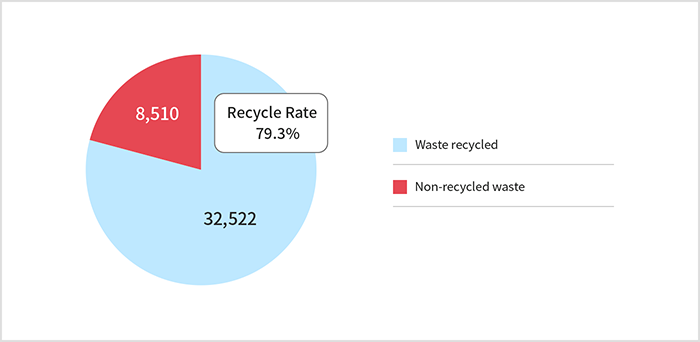
Approach to Harmful Substance Controls and Pollution Prevention
With the growth of our business and the accompanying increase in the creation of harmful substances, we recognize that the reduced creation of waste and appropriate disposal are important management issues.
We also believe that reducing pollutant emissions is one responsibility of companies.
In cooperation with our supply chain, we are working to prevent emissions of harmful substances, to reduce pollutants by not using the materials that cause them, and to realize a recycling society through the appropriate use of resources.
Initiatives to Harmful Substance Controls and Pollution Prevention
The Group appropriately processes and controls harmful substances in accordance with various laws and regulations. As of fiscal 2022, there have been no violations of environmental laws and regulations or environmental accidents since fiscal 2017.
Pollutants and other emissions
Unit: t
| FY2018 | FY2019 | FY2020 | FY2021 | FY2022 | |
|---|---|---|---|---|---|
| NOX | 7 | 9 | 11 | 11 | 12 |
| SOX | 0 | 0 | 0 | 0 | 0 |
| VOC | 0 | 0 | 0 | 0 | 0 |
| PCB | 0 | 0 | 0 | 0 | 0 |
Ratio of Business Locations Which Have Received Environmental Management System Certifications
We have no business locations which have received environmental management certifications such as ISO14001 or EMAS.
Sustainability
Materialities
Promoting Sustainability
Environmental Conservation
Providing and Ensuring Product
Safety and Security, and Promoting
Customer SatisfactionProducts That Contribute to Solving
Social IssuesTalent Development and Labor
PracticesWork-Style Reforms and Promoting
DiversityHealth and Safety
Respecting Human Rights
Supply Chain Management
Regional co-creation Project
Social Contributions
Compliance
ESG Information Index
